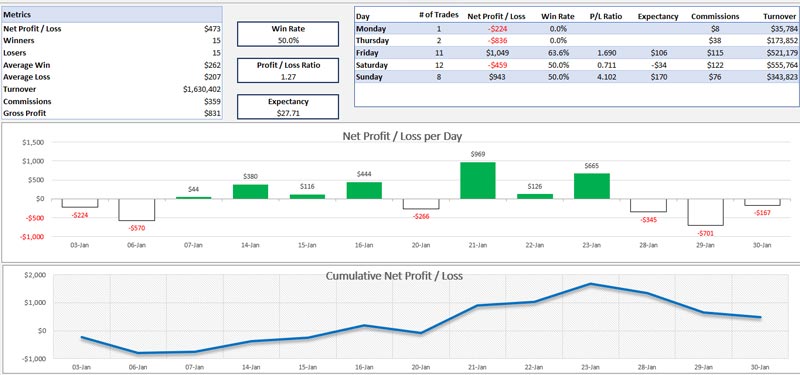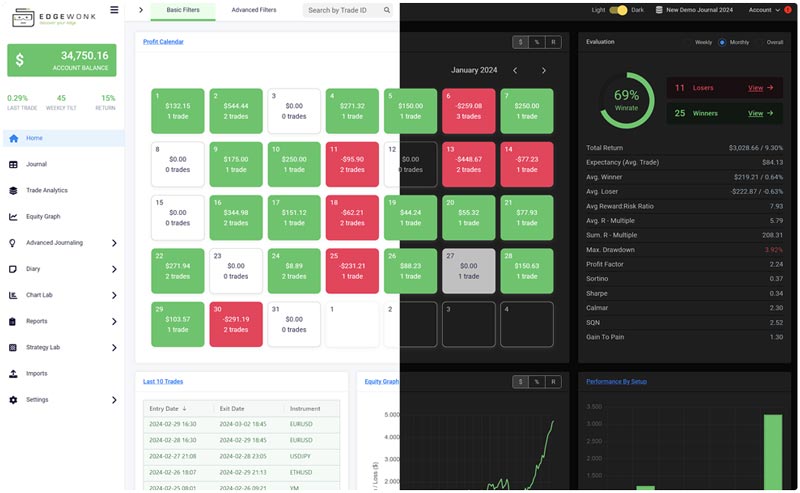What you are about to read:
Trading in financial markets can be both exciting and challenging, and success doesn’t just rely on having the right strategy and forex learning; it also requires discipline, self-awareness, and continuous improvement. One powerful tool that can help traders navigate market complexities and improve their performance is a trading journal.
A trading journal is more than just a record-keeping tool; it’s a roadmap to success that provides valuable insights into a trader’s habits, patterns, and emotions. In this article from BrokerLand, we’ll explore the importance of having a journal in trading, what it entails, how it can be beneficial for traders at all levels, and most importantly, how to create one.
What is a Trading Journal?
A trading journal is a tool for recording records used by traders to track and analyze their trading activities. It serves as a logbook where traders document details of every trade they make in financial markets.
A journal is a vital tool for traders in financial markets, acting as a comprehensive record of their trading activities. In it, traders meticulously document all aspects of their trades from the initial idea to the final outcome, including details such as entry and exit points, position size, reasons for the trade, emotions felt during the trade, and any lessons learned. By systematically recording this information, traders gain valuable insight into their habits, strengths, and weaknesses.
One of the primary goals of a trading journal is performance evaluation. By reviewing past trades, traders can objectively assess their overall performance and identify which strategies work well and which need improvement. This analysis helps traders adjust their approach over time, leading to more consistent and profitable trading results.
Additionally, a trading journal facilitates effective risk management by allowing traders to track their risks and evaluate the effectiveness of their risk management techniques, such as different types of forex orders like stop-loss orders.
Beyond performance evaluation and risk management, a trading journal also plays a crucial role in emotional control. Forex trading can be emotionally challenging, with fear, greed, and FOMO often influencing decision-making. However, by maintaining an accurate record of trades and associated emotions, traders can identify and manage their emotional biases. This self-awareness can prevent emotional biases from affecting trading decisions and lead to more disciplined and rational behavior.
Ultimately, a trading journal is a tool for learning and improvement, serving as a valuable repository of trading experience and allowing traders to learn from their successes and failures. By analyzing past trades, identifying patterns, and adjusting their strategies accordingly, traders can continuously refine their approach to trading.
This iterative process of reflection and improvement is fundamental to becoming a consistently profitable trader. Therefore, a trading journal is not just a record-keeping tool; it is the cornerstone of effective trading performance.
Benefits of Having a Trading Journal
Having a trading journal offers numerous benefits for traders:
- Performance Evaluation: A trading journal enables traders to objectively evaluate their performance by analyzing past trades. They can identify which strategies yield positive results and which do not, leading to adjustments that enhance overall profitability.
- Risk Management: By recording details such as entry and exit points, position size, and risk management techniques, traders can assess their risk exposure in each trade. This allows for better risk management decisions, such as setting appropriate stop-loss levels to avoid being caught in stop hunting.
- Emotional Control: Forex trading can be emotionally taxing, leading to impulsive decisions driven by fear or greed. A trading journal helps traders identify and manage their emotions by documenting their emotional state during each trade. This self-awareness can mitigate the impact of emotional biases on trading decisions and promote more disciplined and rational behavior.
- Learning and Improvement: A trading journal serves as a strategy tester ground and a valuable learning tool, allowing traders to review and analyze their past trades. By identifying patterns, trends, and recurring mistakes, traders can learn from their experiences and continuously improve their trading strategies and decision-making processes.
- Accountability: Maintaining a trading journal reinforces accountability, as traders are accountable for their decisions. Reviewing past trades fosters transparency in behavior and trading outcomes, encouraging responsible trading practices.
- Strategy Optimization: Through analysis of past trades, traders can determine which strategies are most effective in different market conditions and learn valuable insights about timing in volatile market periods like kill zones and suitable strategies for these times. This enables them to refine and optimize their trading strategies over time, increasing their chances of success in the markets.
Generally, a trading journal is an essential tool for traders at all levels of experience, providing a structured framework for self-assessment, risk management, emotional control, and continuous improvement in pursuing trading excellence.
What Does a Trading Journal Include?
A trading journal typically encompasses a comprehensive record of various aspects related to each trade executed by a trader. Here are the key components usually included in a journal:
Trade Details
- Date and time of the trade.
- Financial instrument traded (such as stocks, currency pairs, commodities).
- Long or short position.
- Entry and exit prices.
- Position size (number of shares, contracts, or lots in forex).
- Any commissions or brokerage fees associated with the trade.
Reason for the Trade
- Reason for entering the trade (e.g., technical analysis, fundamental analysis, sentiment analysis, smart money trading method, price action RTM, or trading based on major forex news).
- Forex indicators, harmonic patterns including double top and bottom patterns, or specific forex signals triggering the trade.
- Any forex trends or market conditions relevant to the decision-making process.
Trading Journal and Risk Management
- Stop loss and profit target levels set for the trade.
- Risk-to-reward ratio (potential profit to potential loss ratio).
- Maximum allowable drawdown based on balance and equity.
- Any adjustments made in risk management during the trade to prevent margin calls and losses.
Emotional State
- Trader’s emotional state at the time of entering and exiting the trade.
- Any emotional biases or psychological factors influencing decision-making.
- Reflection on how emotions may have affected the trade outcome.
Trade Outcome in the Trading Journal
- Profit or loss resulting from the trade.
- Return on investment (ROI) percentage or loss.
- Comments on the trade outcome and any unexpected developments.
- Lessons learned or insights gained from the trade.
Additional Notes in the Trading Journal
- Any observations, insights, or additional comments related to the trade.
- Planned actions or adjustments based on the trade outcome.
- Market-related news or events impacting the trade, such as inflation rates, interest rates, or unemployment rates.
- Maintaining stability and accuracy in recording these details is essential for the effectiveness of a journal. Traders may use different formats for their trading journals based on personal preferences and convenience, including extensive spreadsheets, specialized journal software, or handwritten notebooks.
How to Create a Trading Journal?
There are multiple programs and platforms available to assist traders in creating and maintaining their trading journals. These platforms offer various features designed to streamline the process of recording and analyzing trades. Some popular programs and platforms include:
Edgewonk: A comprehensive trading journal and performance analysis platform that helps traders track, analyze, and improve their trading performance. It offers customizable trade tracking, accurate statistics, and advanced analytics for identifying strengths and weaknesses in trading strategies.
TraderSync: TraderSync is a trading journal and performance analysis software that provides tools for tracking trades, analyzing performance metrics, and identifying areas for improvement for traders. Features such as trade tagging, risk management analysis are provided.
TradeBench: TradeBench is a web-based trading journal and analysis platform that allows traders to record trades, track performance metrics, and analyze trading strategies. It offers entry forms, performance reporting, and risk management tools.
Trade Journal: Trade Journal is an app available for iOS and Android devices. It enables traders to record trades, track performance, and analyze trade statistics. Features such as trade tagging, notes, and performance reporting are provided.
My Trading Journal: This site is a web-based journal platform that helps traders track trades, analyze performance, and improve trading strategies. Features such as trade recording, performance analysis, and analytical tools are provided.
These are just a few examples of trading journal apps and platforms available to traders. Each platform may offer unique features and capabilities, so traders should explore different options to find one that best fits their needs and preferences.
Summary
Success in trading is not solely dependent on finding the right website, platform, or broker. Some may prefer prop trading, while others may not; some may prefer MetaTrader 4, while others may connect their account to MQL or use social trading sites. Among forex brokers, one may choose a modern broker like Oppofinance, while another may prefer a broker with more experience like Amarkets. In all of this, the importance of a trading journal and regular review of past trades is undeniable.
A trading journal is an essential tool for traders looking to improve their performance and achieve long-term success in financial markets. By accurately documenting trades, analyzing performance, and reflecting on emotions and decision-making processes, traders can gain valuable insights that lead to improved strategies and results.
Whether you’re an experienced professional or just starting your trading journey, committing to maintaining a trading journal can make a significant difference in your trading success. So take the time to create your daily plan and see how your roadmap leads to trading excellence.











